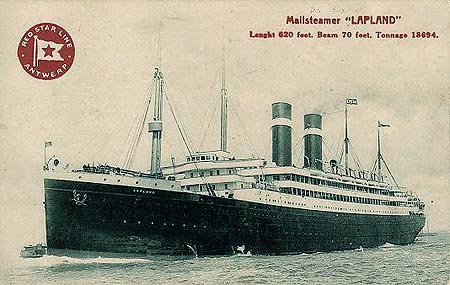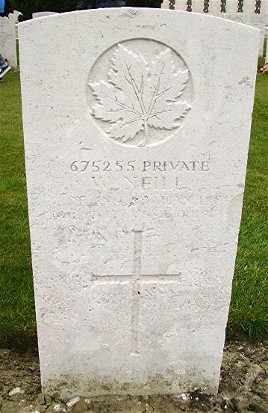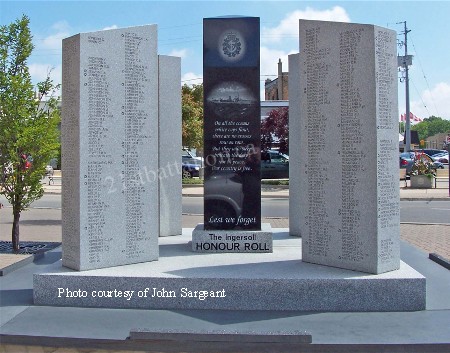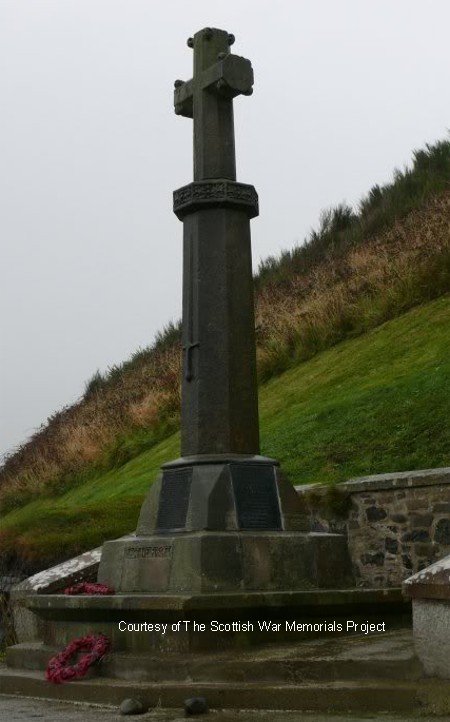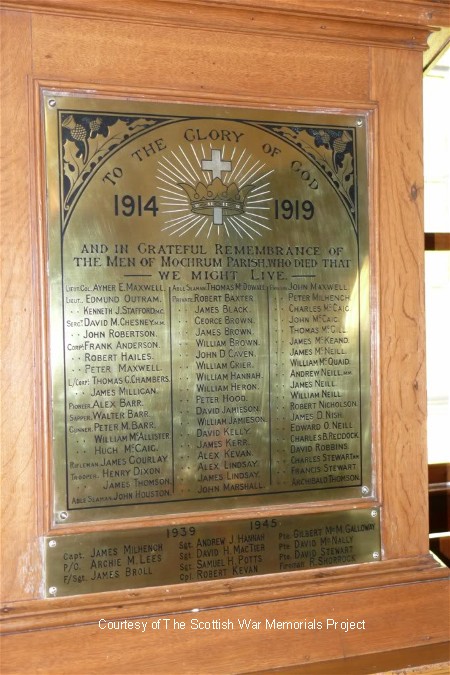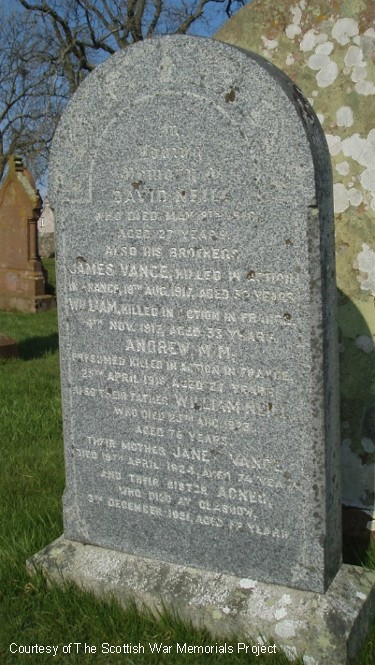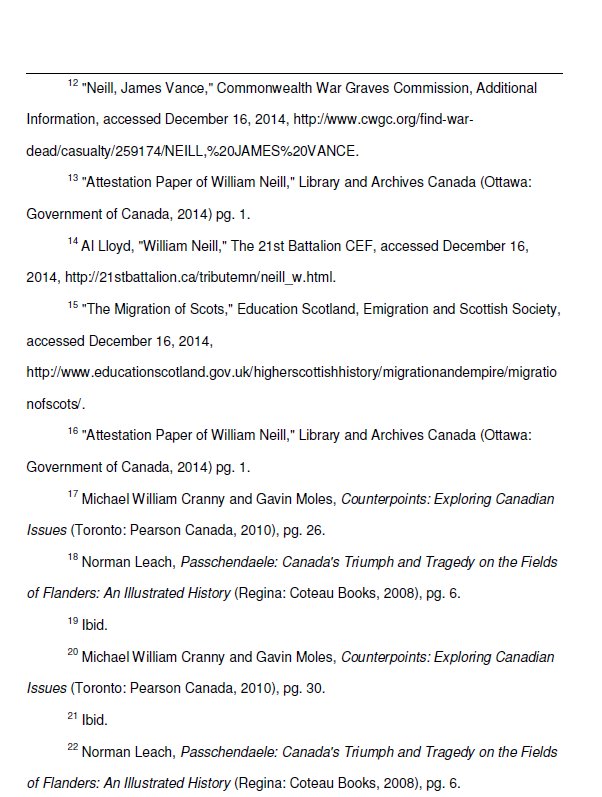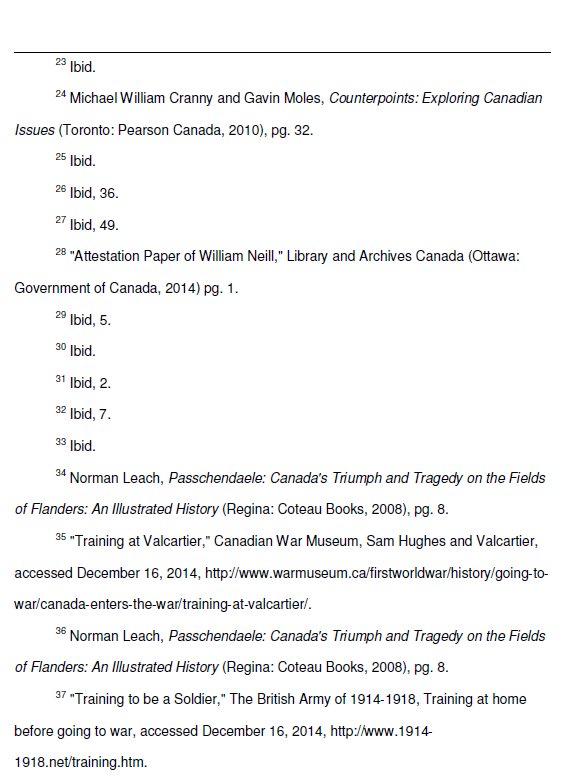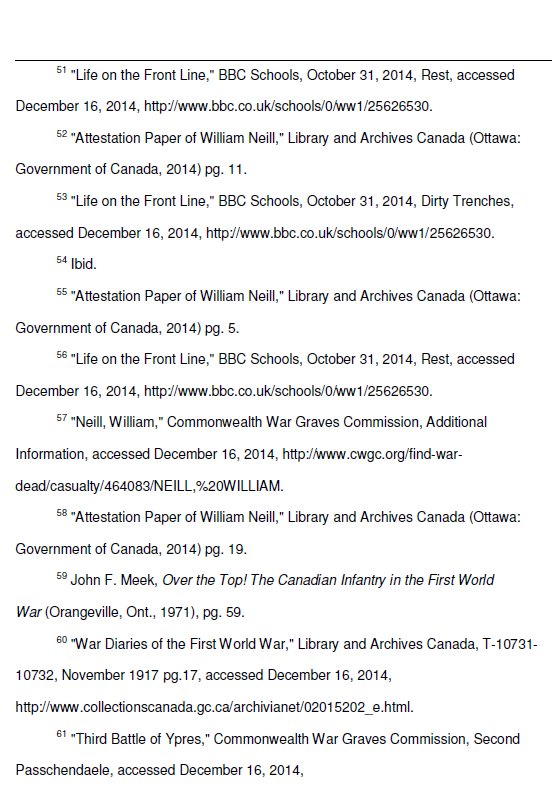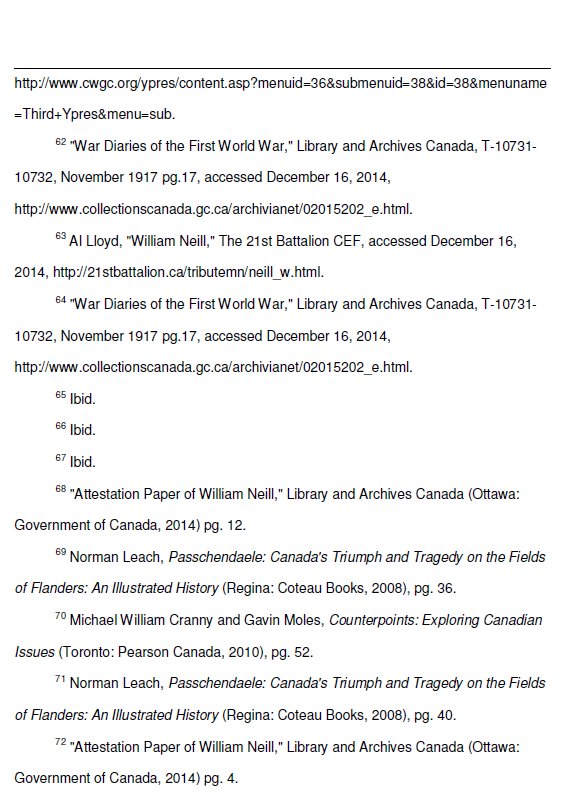| William
Neill
|
||||||||||||||||||||||||
|
||||||||||||||||||||||||
| Private Neill is honoured on the Ingersoll, Ontario War Memorial
|
||||||||||||||||||||||||
| Private William Neill, and his brother, James, are honoured in their
hometown of Mochrum, Scotland, both in the Mochrum Parish Church on a plaque and on the
War Memorial in Port William.
I would like to thank Ken Morrison and the Scottish War Memorials Project for the photos below and for their kind permission to post them here.
Private William Neill, and his brother, James, are also remembered on a family grave marker in the Mochrum Parish Cemetery
|
||||||||||||||||||||||||
|
Late last year I was asked by a student for information and assistance with a school assignment regarding a 21st Battalion soldier. I provided what I had and asked that he send along a copy of the finished project for my files. He sent that along to me, along with permission to reproduce it, and a note that he received a mark of 98.5 percent. The entire paper is below. In Loving
Memory of Private William
Neill Killed in
Action – November 3/4, 1917 Lest We
Forget Kai Lung Social Studies 11-5 Ms. Alexandra December 13th, 2014 |
||||||||||||||||||||||||
|
At the start of the 20th century,
the world was undergoing a time of turmoil. Europe was entering a dark stage. Tensions
arose among nations throughout Europe. Conflicts surfaced, and all signs pointed towards a
war brewing in Europe. At the time, war was the only practical solution to the problems
arising. People felt that fighting and killing each other was the only way to fix things.
With one event leading to the next, the domino effect started a war, dragging with it the
entirety of Europe. Millions flocked to fight in the Great War. It was the start of a
terrifying four year era known as World War One. During this time, millions of lives
perished in their sacrifice for their country. Among the losses was Mr. William Neill, a
Scottish man who fought and died in the war for Canada. Mr. Neill gave his life to help
the British win the war and to try and put a stop to the Great War. His sacrifice was an
act of bravery and loyalty, and he will never be forgotten. William Neill was born
on October 24, 1885 to Janet and William Neill, Esq. in Mochrum, Wigtownshire, Scotland.[i] Mr. Neill was the
middle child in a family of five. He grew up with his parents and his two brothers in
Scotland. Mr. Neill’s two siblings were James Vance Neill, his older brother by seven
years, and Andrew Cloakie Neill who was five years younger.[ii] The three brothers
had a fun childhood at home in Scotland. Being typical boys, they loved to play and they
were very active. When they weren’t at school, they were often playing soccer, rugby,
field hockey, and even golf. Growing up right by the Irish Sea, the three boys enjoyed
spending their time swimming, playing water polo, and horsing around in the water. They
also enjoyed spending quality man-to-man time fishing with their father. Being raised as a
devout Presbyterian, the three brothers went to church every Sunday to gain the wisdom of
the Presbyterian Church.[iii] While he had a great
time in Scotland during his youth years, Mr. William Neill ended up leaving his country to
find a better place to live. During this time in Scotland, many Scots were migrating to
North America and Australia to escape the rural farming lifestyle.[iv] This was because
farmers were extremely poor and had almost no say in their country.[v] Canada on the contrary
was a popular place to immigrate to at this time and was welcoming of British immigrants.[vi] Living in Canada gave
people hope of owning more land and money, and many saw Canada as a land of opportunity.[vii] In hopes of escaping
the low class farming lifestyle in Scotland, William Neill made the decision to immigrate
to the Western world and settle in Canada. On May 30, 1908,
William followed his older brother James’ footsteps by leaving his parents and
younger brother Andrew in Scotland for Canada.[viii] Mr. Neill boarded
the SS Ionian in Glasgow, Scotland and set off on his journey across the Atlantic.[ix] After 10 days, he
arrived in Canada and landed in Quebec City, Quebec.[x] From there, Mr. Neill
proceeded to Ingersoll, Ontario where his brother James had started a family.[xi] Mr. Neill lived on
King Hiram Street in Ingersoll with James and his wife Edith for over seven years.[xii] During his time in
Canada, William became a carpenter and spent his days crafting and building a variety of
things out of wood such as houses, buildings, bridges and more.[xiii] Had he stayed in
Scotland, Mr. Neill would have continued the family business by being a farmer.[xiv] Living in Canada
gave Mr. Neill the opportunity to live a more lavish and happy lifestyle as he received
better working conditions and wages in Canada as opposed to in Scotland.[xv] A lot of the money he
made was sent back home to Scotland to help provide for his parents and younger brother
Andrew. Being a single man, Mr. Neill did not have many responsibilities outside of work
hours.[xvi] Thus, when he
wasn’t hard at work, William was enjoying the Canadian lifestyle and immersing
himself in the unique culture of Canadians. Mr. Neill learned how to ice skate and he
enjoyed playing ice hockey with his new Canadian friends. He figured ice hockey was pretty
similar to field hockey which he had experience playing in Scotland, but was a much more
entertaining version. Coming from a small farming village like Mochrum to a larger city
like Ingersoll was a big change for Mr. Neill, but he loved being able to attend big
social gatherings and going to the bar to meet new people, all of which he wasn’t
able to do back home in rural Scotland. All in all, life in Canada was much different for
William than life back home in Scotland, but Mr. Neill embraced the change and lived his
life to the fullest during these years in Ingersoll. On a more worldwide
scale, tension was growing between countries due to nationalism, militarism and
imperialism within countries in Europe.[xvii] To make things
worse, Austria-Hungary and Serbia were undergoing a conflict that peaked when Serbian
terrorists assassinated Austro-Hungarian Archduke Franz Ferdinand.[xviii] Austria-Hungary
became extremely angry and declared war on Serbia, which caused Germany to then join the
war on the side of Austria-Hungary.[xix] Germany then invaded
Belgium as part of its plan to conquer France which irritated Britain.[xx] Thus, on August 4th,
1914, Great Britain declared war on Germany.[xxi] This chain reaction
pulled most of Europe into war with the British, French and Russians fighting against the
Germans and Austro-Hungarians.[xxii] Britain’s
declaration of war on Germany meant that Canada automatically entered the war against
Germany.[xxiii] When news reached
Canadians that Canada was going to war, people were overjoyed.[xxiv] Many people thought
this would be an exciting twist to their boring daily lives, and most thought the war
would be over by Christmas.[xxv] For the most part,
Canadians supported the decision to go to war, but Mr. Neill hesitated. He was just
getting used to the daily life of being a Canadian and he found he very much enjoyed it.
He did not want to give it all up and risk his life for a war that would supposedly end in
a few months. At the time, the war did not seem very important, and he felt that since
there was a large abundance of volunteer enlistments, his contribution to the war effort
was not necessary. Time proved that Mr. Neill was very wrong. As World War One continued,
millions of lives perished with no signs of either side letting up. What was once viewed
as a gentlemanly and exciting war was quickly replaced with the harsh realities of trench
warfare.[xxvi] Canada slowly began
losing more and more soldiers and desperately needed volunteers to fight for the war
effort.[xxvii] While the
romanticism of war became exposed as false, Mr. William Neill began to feel more and more
obliged to enlist in the army as the war dragged on. He felt a sense of patriotism to
Britain, and he ultimately decided it was the right choice to give back to the two
countries, Scotland and Canada, that had given him everything he had known by serving in
the Great War. It took a year and a half for William to finally realize this, but Mr.
William Neill decided it was time for him to go to war. On January 15th,
1916, just a few months after his 30th birthday, Mr. William Neill attested
into the Canadian Overseas Expeditionary Force (CEF) in his hometown of Ingersoll,
Ontario.[xxviii] Upon signing the
attestation papers, Mr. Neill hereby agreed to serve in World War One on the side of the
Triple Entente. On the day of his attestation, William underwent a medical examination by
a medical officer in Ingersoll.[xxix] The medical officer
discovered that Mr. Neill had a case of varicose veins on his left forearm, which posed as
a possible threat to his service in the war, but it was later deemed as not sufficient
enough of a reason to cause rejection.[xxx] Mr. Neill passed a
variety of tests and was cleared fit for service in the CEF.[xxxi] Thus, Mr. William
Neill was officially attested into the CEF. William joined the 168th Battalion
CEF upon his enlistment and was issued his regimental number of 675225, which was a unique
number that soldiers were issued for identification purposes during World War One.[xxxii] Mr. Neill was also
given the rank of a Private (Pte.).[xxxiii] From this day on,
Mr. William Neill would be known as Pte. William Neill for the rest of his army career.
After the day he enlisted for war, his life would never be the same. Pte. Neill began his
army career by training for the war. Mr. Neill completed his basic training at Valcartier
Training Camp in Valcartier, Quebec.[xxxiv] Valcartier was
Canada’s main training base for the CEF during World War One.[xxxv] At Valcartier,
William received basic military training, such as learning about how all his equipment
worked and how to use and handle weapons safely.[xxxvi] He learned about
individual and unit discipline, which included following commands and marching. He also
had to undergo physical training to keep his body in best shape for the war.[xxxvii] Having no
previous militia experience, Valcartier taught Mr. Neill all the basic things a soldier
needed to know about surviving in a war. He was now ready to go overseas. On October 30th,
1916, after over 8 months of training with his battalion at Valcartier, Mr. William Neill
went to Halifax, Nova Scotia, a frequent final destination for Canadian soldiers.[xxxviii] Here, Mr. Neill
embarked on the SS Lapland and sailed to Europe to fight in the war.[xxxix] After 12 days, Mr.
Neill arrived in Europe at Liverpool, England and immediately traveled across England to
continue his training at West Sandling Army Camp in Kent, England.[xl] Training in England
was different from the basic training he had received at Valcartier. The basic training
that Valcartier had supplied the Canadian soldiers was not enough to prepare them for the
harsh rigours of trench warfare.[xli] At West Sandling,
soldiers received more intensive training. Soldiers learned about war tactics as well as
offensive and defensive strategies, and received more extensive first aid training.[xlii] Soldiers also
learned about individual and unit discipline, which included following commands and
marching.[xliii] After a mere month
spent overseas, Pte. Neill bid farewell to the regiment he had spent almost a year with
when he was taken on strength by the 39th Reserve Battalion CEF.[xliv] After only another
month of advanced training at West Sandling, Pte. Neill switched regiments again on
January 4th, 1917, when his 39th Res. Battalion disbanded and became
absorbed into the 6th Reserve Battalion CEF.[xlv] He and his newly
merged battalion proceeded to the Shorncliffe Army Camp also in Kent, England where they
continued training for the front lines.[xlvi] By this time, Mr.
Neill was tired of all the training he was receiving and craved a taste of the Western
front so that he could truly contribute to the British cause. Therefore, Pte. Neill
decided to transfer out of the 6th Res. Battalion into an active battalion. He
would finally be going to the frontlines, uncovering for himself the truth of World War
One. On March 20th,
1917, Pte. William Neill was taken on strength by the 21st Battalion CEF.[xlvii] Mr. Neill
immediately traveled to the Canadian Base Depot at Rouelles Camp in Havre, France where
the battalion was currently stationed.[xlviii] Upon entering the
21st Battalion, Mr. Neill was reunited with his older brother James, who
happened to be another private in the battalion.[xlix] The two brothers
were overjoyed when they saw each other for the first time since William enlisted into the
army a year ago. They caught each other up to speed with the events of the past year and
they each talked about what life in the war had been like for them. James also informed
William that their younger brother, Andrew had enlisted into the Royal Scots and was
currently fighting at the frontlines in France.[l] They both agreed that
out of the three Neill brothers, Andrew was contributing the most to the war effort. James
and William hoped that they could soon be doing the same as their younger brother by
defending the British flag in war. Life in the 21st Battalion was much
different than William’s previous experiences in reserve battalions. Mr. Neill
received more highly specialized training and most of the training was on the fly as the
battalion was constantly on the move. Fighting for an active battalion also meant that
Pte. Neill finally got to go into the trenches at the front lines. Here, Pte. Neill
finally experienced the truth of World War One. Pte. Neill stayed in the trenches all day
and night with his battalion for days at a time and were either completing daily chores or
fighting the war.[li] They were constantly
on alert and did not get much time to themselves. One advantage Mr. Neill had over the
other soldiers was his short height. Being a mere 5 foot 5 and a half, Mr. Neill was not
forced to crouch down at all times in the trenches to avoid enemy gunfire, which made life
easier on his knees and thighs as well as helping his endurance.[lii] It also made him a
smaller target for the Germans to hit. The trenches were not a fun place to be either.
Trenches were extremely dirty and smelly, and full of bacteria and disease.[liii] Millions of rats
and lice infested the trenches.[liv] It was remarkable
that William never got sick during his service in the trenches.[lv] All the horrible
stories he had heard about trench warfare were proven to be true. Trench warfare was no
joke – it was a horrifying experience that scarred him for life. Whenever he became
unhappy, William reminded himself all the reasons why he was fighting for the war. He
wasn’t just fighting for his personal gain – he was fighting for the safety of
Europe. When the soldiers weren’t
fighting in the war, they enjoyed talking about life back at home in Canada. There were
soldiers of all races originating from all across Canada in his battalion. This allowed
William to learn about the differences between Canadians from different areas. It
wasn’t until William served in the war when he finally saw for himself just how
multicultural Canada truly was. Canada was a land of all peoples. In their free time,
soldiers also enjoyed playing card games such as poker and blackjack, and often wrote
letters home to reassure their families back home in Canada of their safety.[lvi] In short, life in
the trenches was a very traumatic experience for Mr. William Neill, but he strove on in
order to protect the British flag in war. Over the course of the
next five months, Mr. Neill endured the tough life in the trenches. During this time, lots
had happened in his personal life. Mr. Neill lost his two brothers to the Great War,
leaving him as the only Neill brother remaining.[lvii] Since his
enlistment, William had been making $1.10 a day for the past year and a half which by this
time had amounted to almost $330, but it suddenly did not seem like enough to sustain his
parents.[lviii] Money was just a
small part of William’s problems however. His first priority at this time was to
contribute to the war effort and help win this war. He could deal with his money problems
after the war. Thus, Pte. Neill continued to fight on. Over the last five months, Mr.
Neill got a full taste of World War One, fighting in a variety of battles including the
Battles of Arras, Hill 70, and most famously Vimy Ridge before leaving France to fight in
Belgium at the Third Battle of Ypres.[lix] On the night of
November 3rd, 1917 heading into the early morning of the next day, the 21st
Battalion relieved the 72nd Battalion CEF and moved into the Western Front
lines.[lx] This was at the peak
of the Second Battle of Passchendaele, part of the ongoing Third Battle of Ypres.[lxi] During this night,
the Germans made a determined attack on the 21st Battalion and entered the
battalion’s trenches northeast of Crest Farm, but were forcefully ejected by the
battalion members.[lxii] It was a tough
fight, but Pte. Neill survived this ordeal unscathed and lived to see the Germans being
pushed out of their trenches.[lxiii] However, many of
his mates did not hold the same fate. Later in that same night, the Germans made two more
counterattacks.[lxiv] Both times, the
enemy was beaten back and forced to retreat as the Canadians stood their ground.[lxv] The Canadian
battalion re-grouped, re-organized and re-established the front line, but it was too late
for many Canadian soldiers.[lxvi] The damage had
already been done by the Germans that night. During the 24 hours of November 3-4, 1917,
the 21st Battalion lost over 100 men.[lxvii] Among the dead was
Pte. William Neill.[lxviii] Throughout the war,
Pte. Neill gave it his all. The night of his unfortunate death was an act of true valour
by Mr. Neill but it was not enough to save his own life. Pte. Neill sacrificed his life
for the war and the better of the British people. After his death, his battalion rallied
to keep the Germans away from their trenches and played a key factor in scoring a victory
for the Triple Entente at the Battle of Passchendaele.[lxix] The victory in this
battle put the British one step closer to ending the war. It took another year of
miserable fighting, but on November 11th, 1918, an armistice was signed
officially signifying the end of World War One.[lxx] Four years of
horrific fighting had finally concluded, but at the cost of millions of dead soldiers.[lxxi] After the war
ended, Pte. Neill’s entire estate was passed along to his mother, Janet Neill, as
stated in a will he had written back on March 8th, 1917.[lxxii] His mother
received all of William’s belongings, including his money and possessions, but at the
insurmountable cost of losing her beloved son. His mother was also awarded the British War
Medal, Victory Medal, Memorial Plaque and Scroll as well as the Memorial Cross, all given
to family members of British servicemen who had died overseas in the war.[lxxiii] These were all
sent to her home in Mochrum, Scotland, Mr. Neill’s childhood home. Today, Private
William Neill is buried at the largest Commonwealth war cemetery in the world, the Tyne
Cot Cemetery in Passchendaele, Belgium.[lxxiv] Among almost
12,000 other servicemen, Mr. Neill lies to rest in Grave 9 of Plot 2, Row CC in the
cemetery.[lxxv] His grave is
located just kilometers away from where he lost his life, overlooking the fields where he
once roamed during the war.[lxxvi] He is also
commemorated by his Canadian hometown on the Ingersoll War Memorial in Ingersoll, Ontario,
as well as on page 300 of the First World War Book of Remembrance.[lxxvii] His life may have
been lost, but his spirit shall always live on. His character will be forever captured and
remembered. Mr. William Neill was
a man who craved adventure. He moved from Scotland to Canada in search of more
opportunities and a better future. Whilst in Canada, William got what he was searching for
and he loyally gave back to Canada with his efforts in the war. He was a man with great
morals. Pte. Neill was always eager to contribute to the war and he volunteered to fight
on the dangerous front lines. It is a shame that he died so early in his life, as he had
many decades of his life still ahead of him to look forward to. Mr. Neill gave up his
future for the better of Canada, and his noble sacrifice for Canada will be remembered
forever. He died proudly with the maple leaf on his chest. Mr.
William Neill was a brave and loyal man who died for his country, and he will never be
forgotten. |
||||||||||||||||||||||||
|
|
||||||||||||||||||||||||


